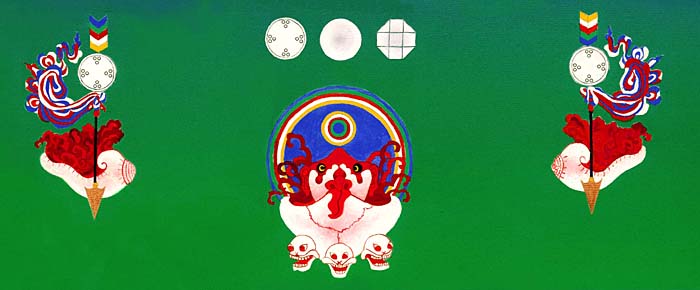
A-shé Khandro
offerings
The offerings shown here are typical of those found on Aro gTér thangkas. The idea of offerings on a thangka or on a shrine concerns ‘making a connection’. When one visits someone – one takes a gift of some kind which speaks of one’s knowledge of that person. This gift is then a communication – and in terms of a thangka, a two-way communication of wisdom. The offerings on each thangka represent aspects of the yidam or of the lineage Lama, in terms of how one would prepare oneself in order to arise in such a form.
The central offering is the wrathful offering of the five senses. A skull bowl contains the ocean of the blood of slaughtered referentiality – along with the eyes, ears, nose, tongue, and heart. Touch is represented by the entire assemblage of organs as the tactile sense. The idea of a wrathful offering concerns the transformation of the most intense form of dualism and is therefore a symbol of the colossal energy of transformation.
Below A-shé Khandro and above the sense offerings are the three symbols of energy in terms of the Dzogchen teachings. The crystal sphere in the middle represents dang (gDangs) – the all-encompassing experience of the nature of undivided internal and external energy. The mirror or mélong represents rolpa (rol pa) – the inner experience of visionary energy. The faceted crystal represents tsal (rTsal) – the outer experience of energy in terms of apparent external phenomena.
On either side are the conches which are paired with male and female long-life arrows. The conch is a female symbol. The white of the conch is the male quality of spacious-passion. The red frothing oceans of menstrual blood within the conch is the female quality of passionate-space.
